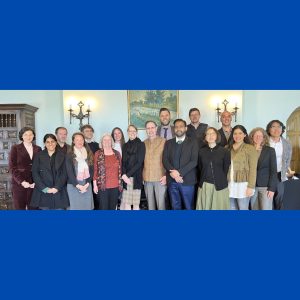
Celebrating the Goldmans at UC Berkeley, April 29-30th, 2022
Renowned Sanskrit professors Robert P. Goldman and Dr. Sally Sutherland Goldman retired last spring from their distinguished teaching careers at UC Berkeley. Authors of the much-loved Sanskrit language textbook, the Devavāṇīpraveśikā, “Introduction to the Language of the Gods” (used in Sanskrit language instruction at DRBU), these torchbearers of Sanskrit scholarship are succeeded by a generation of students trained by them who strive to carry on their work. To honor their illustrious careers and innumerable contributions in the field of Sanskrit literature and South Asian Studies, the UC Berkeley Institute for South Asia Studies organized a two-day conference this past April 29–30th, 2022, bringing together nineteen current and former students of the Goldmans who continue their scholarly legacy – among these DRBU faculty members Lauren Bausch and Sean Kerr. Over two days of conference presentations showcasing the work of their students and the formative influences of the venerable gurū (dual of guru), the Goldmans were warmly recalled for their unstinting support, impossibly high standard, and above all for their signature focus on Sanskrit commentarial literature and the diverse and often creative interpretive strategies Sanskrit commentators apply in their reading of classic texts. Students expressed gratitude at having received their academic training – and all-embracing ethical and humanistic vision – in what was affectionately dubbed the “Goldman school of commentary”.
Abstracts from DRBU faculty presentations
Vedic ātmáns – Lauren Bausch, Assistant Professor, Dharma Realm Buddhist University
Kamaleswar Bhattacharya (1973/2015: 37) makes the case that Buddhism never denied the Vedāntic ātman, but only the phenomenal ātman—in terms of anātman—in order to prepare people to directly know the ātman. Similarly, C.V. Jones (2021) provides evidence that alongside conventional anātman discourses, some Buddhist texts present the Buddha, Tathāgatagarbha, and Buddhadhātu as synonymous with the ātman. In this way, Buddhism distinguishes two types of ātman: one conditioned, subject to karma and transmigration, and another unconditioned, ever present, but knowable only to fully awakened beings. To what extent do these two ātmans correspond to Vedic thought? This paper reexamines common assumptions about ātman as: invariably denoting “self,” singular, and the antithesis of the Buddha’s teaching. A philological study of ātman in the Brāhmaṇa texts suggests that ātman in late Vedic is more nuanced than it is presented in Śaṅkarācārya’s Advaita Vedānta and Mīmāṃsā, which for historical reasons have become dominant lenses through which to interpret this concept. Understanding the Vedic context sheds light on the different usages of ātman in circulation and, as a result, the assorted conditions to which the Buddha taught.
Buddhist Spins on Mindfulness of Breathing – Sean Kerr, Assistant Professor, Dharma Realm Buddhist University
My work focuses on the articulations of Buddhist theory and practice contained in the lesser-known works of the Pali exegete Anuruddha. In this talk I look at Anuruddha’s presentation of the Buddhist practice of mindfulness of breathing (ānāpāna-sati) in his work, the Nāmarūpapariccheda, and reflect on its obvious antecedents in canonical sutta literature, as well as its less obvious antecedents in the non-Theravāda sources implied in its formulation. The development of thought, practice, and the interpretation of canonical sources suggested by this examination occasions reflection on the “spinning” of canonical texts frequently observable in exegetical traditions – a point made memorably by Robert P. Goldman in an early article – highlighting the subtle disjunctions between exegetical claims to fidelity and authoritative texts and teachings (and, in this case, practices).